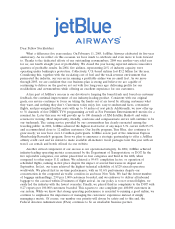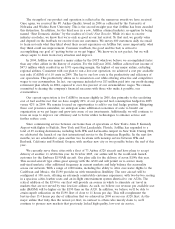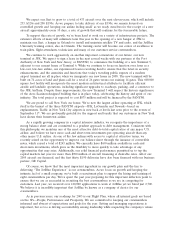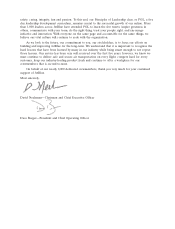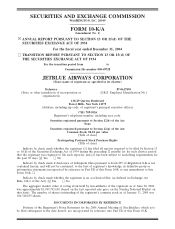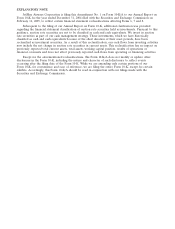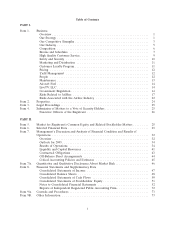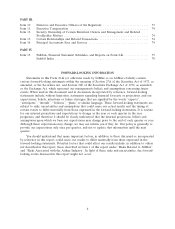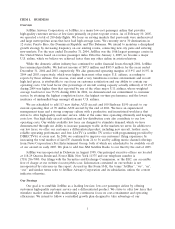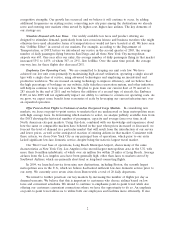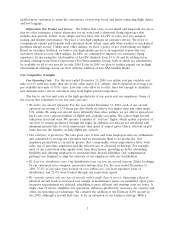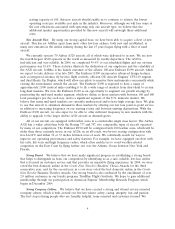JetBlue Airlines 2004 Annual Report Download - page 2
Download and view the complete annual report
Please find page 2 of the 2004 JetBlue Airlines annual report below. You can navigate through the pages in the report by either clicking on the pages listed below, or by using the keyword search tool below to find specific information within the annual report.The strength of our product and operation is reflected in the numerous awards we have received.
Once again, we received the #1 Airline Quality Award in 2004 as calibrated by the University of
Nebraska and Wichita State University. This is the second straight year that JetBlue has been awarded
this distinction. In addition, for the third year in a row, JetBlue attained industry recognition by being
named ‘‘Best Domestic Airline’’ by the readers of Cond´
e Nast Traveler. While it’s nice to receive
industry accolades, we know that we’re only as good as our last arrival. To that end, we greatly value
and depend on the feedback we receive from our customers. We survey 600 customers daily via email
to learn not only what they liked about their recent experience on JetBlue but, more importantly, what
they think could use improvement. Customer feedback, the good and the bad, is critical to
accomplishing our goal of ‘‘getting better as we get bigger’. We know we’re not perfect, but we will
always aspire to learn from every situation and improve.
In 2004, JetBlue was named a major airline by the DOT which we believe we accomplished faster
than any other airline in the history of aviation. For the full year 2004, JetBlue achieved net income of
$47.5 million which resulted in an 8.9% operating margin, the highest of any major airline, excluding
regional airlines. Consistent with our plan to run a low-cost operation, we achieved a cost per available
seat mile (CASM) of 6.10 cents in 2004. The key to our low costs is the productivity and efficiency of
our operations. This productivity allows us to remain low-cost while offering attractive and competitive
wages to our crewmembers. In fact, our expenses included over $13 million paid into our profit-sharing
retirement plan which, in 2004, equated to over five percent of our crewmembers’ wages. We remain
committed to sharing the company’s financial successes with those who make it possible, our
crewmembers.
Our current expectation is for CASM to increase slightly in 2005, due primarily to the escalating
cost of fuel and the fact that we have roughly 20% of our projected fuel consumption hedged in 2005
versus 42% in 2004. We remain focused on opportunities to add to our fuel hedge position. Mitigating
these cost pressures somewhat, we anticipate some additional economies of scale to benefit our
organization as we get larger and grow into some of our investments. Additionally, we will continue to
focus on ways to improve our efficiency and to better utilize technologies to enhance service and
further reduce costs.
Since commencing service between our home-base of operations at New York’s John F. Kennedy
Airport with flights to Buffalo, New York and Fort Lauderdale, Florida, JetBlue has expanded to a
total of 29 exciting destinations, including both JFK and LaGuardia Airport in New York. During 2004,
we celebrated the launch of our first international service to the Dominican Republic. In the next few
months, we are scheduled to open another two locations with nonstop service between JFK and
Burbank, California and Portland, Oregon, with another new city or two possible before the end of this
year.
We currently serve these cities with a fleet of 73 Airbus A320 aircraft and have plans to accept
delivery of another 11 A320s this year. In October 2005, our airline will be the world-wide launch
customer for the Embraer E190AR aircraft. Our plan calls for the delivery of seven E190s this year.
This second aircraft type offers great synergy with the A320 and will permit us to service many
mid-sized markets, offer additional frequency in current markets and help balance the seasonality
across our network. With a range of 2,000 miles, including the ability to offer over-water flights to the
Caribbean and Mexico, the E190 provides us with tremendous flexibility. The new aircraft will be
configured at 100 seats, offering an extremely comfortable customer experience, with two-by-two seating
in a spacious cabin, leather seats and an in-flight entertainment system identical to our A320s. The
critical addition of the E190 to our fleet will provide an avenue in which to stimulate air travel in
markets that are not served by true low-fare airlines. As such, we believe our revenue per available seat
mile (RASM) will be higher on the E190 than on the A320. In addition, we believe we’ll be able to
attain superb utilization on the E190 fleet of close to 11 hours per day. This will complement the
best-in-class 13.4 hours per day of utilization that we achieved in 2004 across our A320 fleet. As the
major airline that truly flies the newest jet fleet, in contrast to others who merely claim to, we’ll
continue to pioneer new markets that previously lacked high-quality, low-cost air service.

